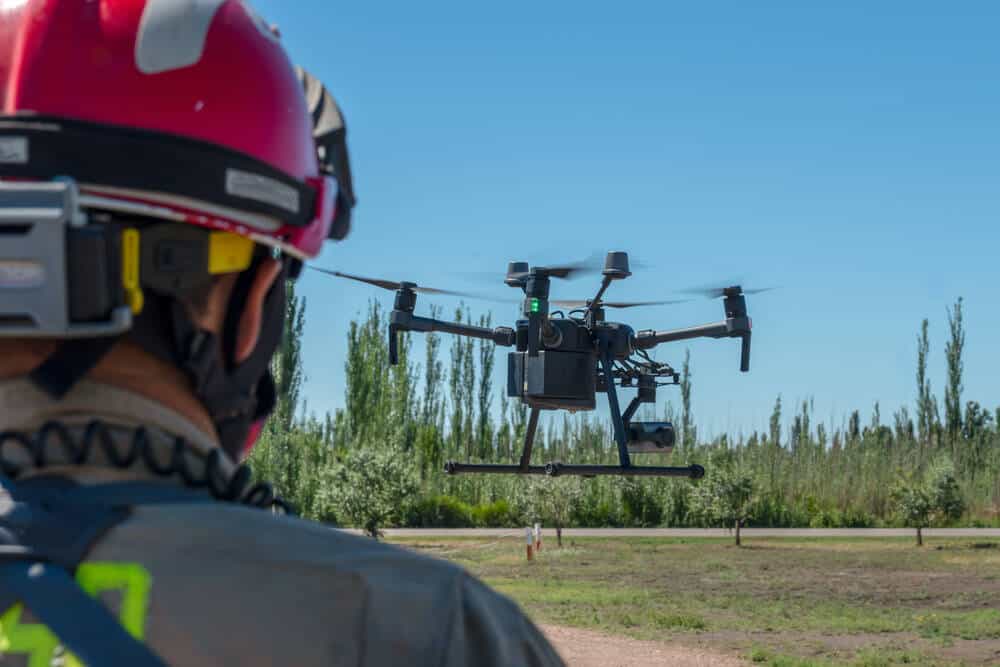- AI enables progress in earthquake prediction efforts
- Locating earthquake epicentres with the help of AI
- Disaster analytics platform provides potential damage information
- Modular sensor system for drones helps people buried under rubble
- Rats with high-tech backpacks help search for earthquake survivors
- Quadruped robot with multispectral camera locates earthquake victims
Devastating earthquakes can happen at any time, often without warning. Did you know that worldwide, approximately 8,000 earthquakes happen every day? While these are predominantly caused by the shifting and moving of the earth’s crust, they can also be caused by mining, gas extraction, groundwater extraction, (nuclear) explosions, volcanic eruptions, and even meteorites. And while advancements in technologies — such as artificial intelligence (AI), sensor technology, and so on — can help us better understand and predict earthquakes, recent events that devastated Syria and Turkey are a grave warning and a very clear indication that we still have quite a way to go when it comes to forecasting these and other natural disasters. Johannes Schweitzer, principal research geophysicist at NORSAR, a research foundation that specialises in seismic monitoring and seismology, explains: “Successful earthquake prediction must provide the location, time, and magnitude of a future event with high accuracy, [something] which as of now, can’t be done”. In recent years, however, new technologies — like smart infrastructure, early warning systems, and disaster management innovations — have emerged that aim to help communities better prepare for earthquakes, improve search and rescue operations, and ensure that loss of life, disruption of essential services, and economic loss are minimised.
- AI enables progress in earthquake prediction efforts
Researchers at the Israeli Ariel University’s Department of Physics, led by Dr Yuval Reuveni, recently published a report showing significant progress in the development of earthquake prediction technology. The team used artificial intelligence (AI) and machine learning algorithms to find precursors to earthquakes by studying electron levels in the ionosphere. The researchers used a support vector machine (SVM), a supervised machine learning algorithm that is often used in bioinformatics, text classification, and image classification. When the researchers combined SVM with GPS ionospheric total electron content (TEC) time series estimations, they discovered that the TEC could actually be used to predict the precursors of large earthquakes with an accuracy of 83 per cent. According to the report, which was published in the peer-reviewed journal Remote Sensing, “observational and modelling results have confirmed the existence and detectability of earthquake and tsunami signatures in the ionosphere caused by both acoustic and gravity waves. While this is not yet a foolproof method of predicting earthquakes, it is a promising step forward in our efforts to better understand and anticipate seismic activity”.
- Locating earthquake epicentres with the help of AI
While the shocks of the initial earthquakes are often the most severe and dangerous, the aftershocks can cause untold devastation as well and are sometimes even more damaging than the initial shock. To accurately predict aftershocks, it’s important to locate the earthquake epicentre. This is typically done by seismologists, which is not only time-consuming but requires significant staff resources and also gets influenced by the subjectivity of the seismologist’s findings. Now, a neural network has — for the first time — shown that it can make a significant contribution to the accuracy of epicentre determinations, which improves the prediction of aftershocks. A team of researchers at the Karlsruhe Institute of Technology (KIT) used the neural network to determine the time of arrival of seismic waves. The AI was trained using the data of 411 earthquakes in northern Chile, which enabled the researchers to predict aftershocks much more accurately than previous algorithms have been able to do. The predictions by the neural network also matched the precision of human seismologists in determining the arrival time of seismic waves. Professor Andreas Rietbrock from the Geophysical Institute (GPI) at KIT says: “Our results show that artificial intelligence can significantly improve earthquake analysis — not only with the support of large data volumes but also if only a limited dataset is available”.
“In a globalised world, having real-time access to valuable data and insights has become critical to understand, assess, and make fast-paced decisions impacting lives, costs, and operations”.
Gregory Dewerpe, founder A/O Proptech
- Disaster analytics platform provides potential damage information
Not only is it critical to develop ways to predict the location of an earthquake more accurately, but it is also important to have access to accurate information about the damage caused by an earthquake. Founded in 2015 by catastrophic risk management veterans and structural engineers, the US-based startup Safehub makes use of IoT sensors, third-party data, and analytics to provide real-time earthquake damage information. This includes data on damage to buildings and related business interruption losses, but also on casualties, trapped or injured people, and people who need shelter — to help mitigate the destruction caused by these disasters. The platform developed by the company analyses the information gathered and, based on its findings, sends out alerts via an internet-based dashboard or via emails or text messages. Gregory Dewerpe, founder of A/O Proptech, a property technology venture capital firm in the UK, explains: “Extreme weather and natural disaster-related interruptions have the potential to be just as devastating to companies around the world, regardless of their location. In a globalised world, having real-time access to valuable data and insights has become critical to understand, assess, and make fast-paced decisions impacting lives, costs, and operations”.
- Modular sensor system for drones helps people buried under rubble
When natural disasters strike, it often takes a long time before people who are buried under rubble can be located and rescued. In order for search and rescue teams to have access to faster and more accurate information about the situation in a particular disaster zone, a team of international scientists working on a research project called Systems for Localising Buried Persons in Collapsed Buildings (SORTIE) has developed a modular sensor system for drones. The team has developed four sensor packages that can be connected to the drone, including a ‘debris structure analysis’ package to assess the stability of debris; a ‘laser gas measurement’ package for the remote detection of explosive air mixtures; a ‘bioradar’ package to detect the breathing movements of buried victims; and a ‘mobile phone location’ package. Professor Ompe Aimé Mudimu, who heads a project on this topic at the Institute of Rescue Engineering and Hazard Mitigation at the Cologne University of Technology in Germany, says: “Building collapses often happen suddenly and without warning, such as with gas explosions or earthquakes. Search and rescue teams can usually only move slowly on the unstable rubble of the ruins. Thus it is very important to be able to search extensive areas efficiently and safely. Analysis from the air using drones is particularly suitable for this purpose. This would relieve the burden on emergency forces searching for buried victims”.

- Rats with high-tech backpacks help search for earthquake survivors
The Belgian non-profit APOPO has developed tiny high-tech backpacks for rats to help search and rescue teams locate survivors in disaster zones. The rodents’ excellent sense of smell and tiny size make them the ideal creatures to find items or people in small, tight spaces. The leader of the project, behavioural research scientist Donna Kearn, says: “Rats are typically quite curious and like to explore — and that is key for search and rescue”. In a simulated disaster zone, the little animals are being trained to locate ‘survivors’. But first, they learn how to find the target in an empty room. Once the target is located, they must pull a switch on their vest, which sets off a beeper. Then they go back to their base, where they get a treat. For the development of the tiny high-tech backpack, APOPO has partnered with electrical engineer Sander Verdiesen at the Eindhoven University of Technology in the Netherlands, who was “looking to apply technology to improve lives”. The prototype he built was made from a 3D-printed plastic container that holds a two-way microphone, a location transmitter, and a video camera that sends live footage to a laptop and stores a version on an SD card. The container was then put in a neoprene vest and attached to the rat. Verdiesen hopes that “one day it can help first responders locate somebody that would otherwise not be rescued”.
- Quadruped robot with multispectral camera locates earthquake victims
Not only drones and rodents but also quadruped robots are being deployed to help locate earthquake victims. A team of researchers at the Polytechnic University of Madrid have developed an autonomous four-legged robot that makes use of artificial intelligence (AI) and a multispectral camera to search for victims of natural disasters, such as earthquakes. The robot is remote-controlled and can be deployed in various dangerous and otherwise inaccessible areas, such as collapsed buildings. The team trained several convolutional neural networks (CNNs) to identify human shapes in between rubble, such as a hand, a head, or a torso. They then compared their technique to several earlier systems that typically make use of infrared or red-green-blue imaging to locate victims. They conclude that their multispectral system, which uses five wavelengths: blue, green, and red visible light, red edge light, and near-infrared light, has greater versatility when used to find people in indoor as well as outdoor locations.
In closing
While accurately predicting earthquakes is still a challenge we’re trying to master, early warning systems are getting better and better. Advances in research and technology enable the development of increasingly sophisticated systems that will become more and more instrumental in our efforts to reduce the human, social, and economic toll of earthquakes. Technology deployed in search and rescue missions is undergoing significant advances as well. Robots — and even animals — are increasingly used to search for survivors in the aftermath of natural disasters, as they can operate in hazardous environments and access small, rubble-filled areas to find survivors.
Share via:


